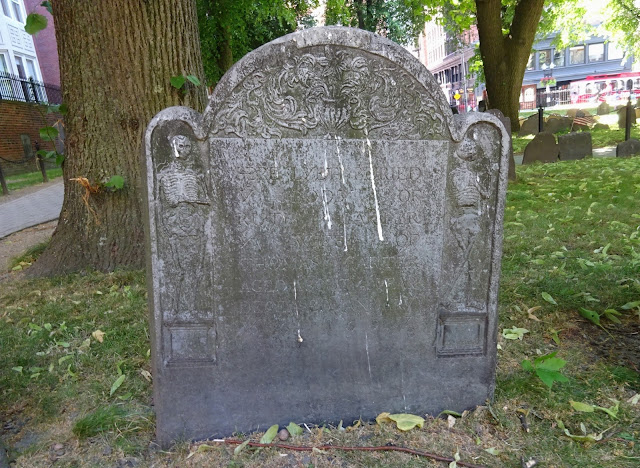 |
| The Granary Burying Ground, Boston, MA |
A visit to an art exhibit displaying the works of N. C. Wyeth called the Men of Concord, in the Concord Museum, Concord, Massachusetts put me on another research trail, like many others I've blogged about. This one led me to two cemeteries (Concord and Boston), a library for a book and the internet for information. I could have written about each of them (the art exhibit, the two cemeteries, the book, and the internet), but I wanted to write one piece tying in all the elements.
So how did my inspiration come about for writing this post?
 After Seeing the painting, Mr. Alcott in the Granary Burying Ground in Boston, in the museum, my first thought was, "this is an idea for a post", because I love that cemetery.
After Seeing the painting, Mr. Alcott in the Granary Burying Ground in Boston, in the museum, my first thought was, "this is an idea for a post", because I love that cemetery.
I knew immediately I had find the cemetery stone behind Mr. Alcott. The internet helped because I found all I needed to know about the stone and painting from an article in the Boston Athenæum which stated, "The location that Wyeth chose for his painting, however, can be pinpointed because he had included in the foreground the gravestone of one Ruth Carter, which has survived and is very well preserved. The stone is, in fact, a masterwork of American gravestone carving and one can understand why Wyeth gave it a place of prominence in his composition. Here, elegantly posed and carved skeletons, obvious allegories engaged in the dance of death, flank the incised inscription that summarizes Mrs. Carter's brief life."
I checked on FindAGrave and saw a very clear photo taken rather recently. So, I knew I had to see that tombstone in person.
I then decided to get the book, Men of Concord out of the library, after all, that is the name of the art exhibit I attended.
None of the above was worthy of a singular blog post until I read the chapter on A. Bronson Alcott. Then I knew I had to write a post, not about the fabulous cemetery stone or the painting, but what Henry David Thoreau wrote about Bronson's love of genealogy.
But, sometimes I change my mind, and I did several times with this post because of so many elements. Sharing my steps that lead up to this finalized post. First, the art exhibit.
I wrote about finding the painting at the Boston Athenaeum, my accident, and wrote about it HERE.
After seeing the above exhibit, I had to find the stone behind Mr. Alcott, for two reasons. First to see if that person was related to me, and second, it was a fabulous stone, with full-length skeletons on each side. I located it and determined that Ruth Carter was not a relative, and the stone needed to be cleaned! (I made this black and white, and it's the last photo shown.)
Another cemetery trip took us to the Sleepy Hollow Cemetery in Concord, Massachusetts. I had been there many times, but I hadn't taken a photo of Bronson Alcott's stone. Shown below is a listing of all family members on the back side of the tall marker. You'll note, that Louisa May Alcott's middle name is after her mother's surname. Henry David Thoreau's stone is a few steps away.
AMOS BRONSON ALCOTT
1799 --- 1888
ABIGAIL MAY ALCOTT
1800 --- 1877
ANNA BRONSON ALCOTT PRATT
1831 --- 1893
LOUISA MAY ALCOTT
1832 --- 1888
ELIZABETH SEWALL ALCOTT
1835 --- 1858
MAY ALCOTT NIERKIKER
1840 --- 1879
 |
| Each person has a small stone with initials and dates. |
Pages 79-80
August 11, 1852.
A. Bronson Alcott
Alcott here the 9th and 10th.
...he has been for some months, devoted to the study of his own genealogy...
has faithfully perused the records of some fifteen towns, has read the epitaphs in as many churchyards, and, whenever he found the name Alcock, excerpted it and all connected with it...
...now reading the wills and the epitaphs of the Alcocks with the zeal of a professed antiquarian and genealogist!
Nevertheless the similarity of name is enough, and he pursues the least trace of it.
He visited the tomb of Dr. John Alcock in the Granary Burying Ground, read, and copied it.
Has visited also the only bearer of the name in Boston, a sail-maker perchance,--though there is no evidence of the slightest connection except through Adam,--and communicated with him.
He says I should survey Concord and put down every house exactly as it stands with the name.
Admires the manuscript of the old records; more pleasing than print.
He copied the epitaph of my grandmother-in-law which he came across in some graveyard (in Charlestown?), thinking 'it would interest me!'





























































